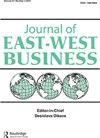俄罗斯地区的COVID和制裁弹性:以2010-2022年罗斯托夫州为例
IF 0.9
Q4 BUSINESS
引用次数: 0
摘要
摘要使用收敛估计,罗斯托夫州城镇和地区的经济对四种经济冲击具有弹性-初始制裁(2019年),初始COVID和持续制裁(2020年),持续制裁和恶化的COVID(2021年),战争,更严厉的制裁和下降的COVID(2022年)。农业产出具有弹性,是俄罗斯经济的重要增长部门。住房和建筑面积是有弹性的,即使生产总值保持不变。劳动力指标显示,2020年失业率和职位空缺将受到严重冲击,随后是2021年的复苏,2022年的劳动力市场将大幅收紧。关键词:ConvergenceO47R11R12resiliencyRostov地区披露声明作者未报告潜在利益冲突。注1到2022年3月,这些区域分支网站上的数据大部分消失了几个月。然而,这些数据在2022年秋季的某个时候重新出现,现在可以获得前几个月的报告我们也研究了每平方公里的这两个变量,但结果和只看总产量没有什么不同。从2014年到2022年,每平方公里的总面积从8个增加到16个,每平方公里的独户住宅面积也从6个增加到14个。本文章由计算机程序翻译,如有差异,请以英文原文为准。
COVID and Sanctions Resiliency in a Russian Region: The Case of Rostov Oblast 2010–2022
AbstractUsing convergence estimations, the economies of the towns and districts of Rostov Oblast are shown to be resilient to four shocks to the economy – initial sanctions (2019), initial COVID and continuing sanctions (2020), continuing sanctions and worsening COVID (2021), war, harsher sanctions and declining COVID (2022). Agricultural output is resilient and represents an important growth sector for the Russian economy. Housing and floor area construction are resilient with even gross production being maintained. Labor indicators show a severe shock to unemployment and vacancies in 2020 followed by recovery in 2021 and a much tighter labor market in 2022.Keywords: ConvergenceO47R11R12resiliencyRostov region Disclosure statementNo potential conflict of interest was reported by the author(s).Notes1 In March 2022 most of these data on the territorial branch web sites disappeared for several months. However, these data reappeared sometime in fall 2022 with prior months reports now available.2 We did look at both of these variables per square kilometer as well, but the results are no different than just looking at gross production only. Overall area per square kilometer doubled from 8 to 16 between 2014 and 2022 while area per square kilometer for single family housing doubled from 6 to 14 as well.
求助全文
通过发布文献求助,成功后即可免费获取论文全文。
去求助
来源期刊

Journal of East-West Business
BUSINESS-
CiteScore
2.10
自引率
26.70%
发文量
19
期刊介绍:
Journal of East-West Business is a quarterly journal that deals with contemporary and emerging aspects of business studies, strategies, development, and practice as they relate to the Russian Federation, the new republics of the Commonwealth of Independent States, and Eastern/Central Europe-and business relationships with other countries of the world. The Journal of East-West Business is international in scope and treats business issues from comparative, cross-cultural, and cross-national perspectives. The journal features an Editorial Advisory Board that represents the Russian Federation, Eastern/Central European, and Baltic states in this new business arena.
 求助内容:
求助内容: 应助结果提醒方式:
应助结果提醒方式:


